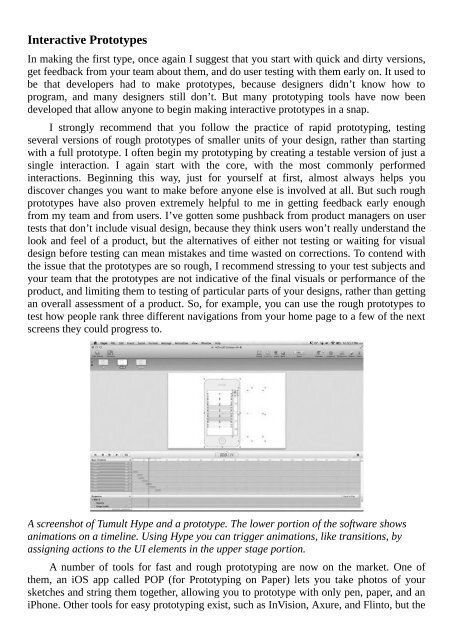You also want an ePaper? Increase the reach of your titles
YUMPU automatically turns print PDFs into web optimized ePapers that Google loves.
Interactive Prototypes<br />
In making the first type, once again I suggest that you start with quick and dirty versions,<br />
get feedback from your team about them, and do user testing with them early on. It used to<br />
be that developers had to make prototypes, because designers didn’t know how to<br />
program, and many designers still don’t. But many prototyping tools have now been<br />
developed that allow anyone to begin making interactive prototypes in a snap.<br />
I strongly recommend that you follow the practice of rapid prototyping, testing<br />
several versions of rough prototypes of smaller units of your design, rather than starting<br />
with a full prototype. I often begin my prototyping by creating a testable version of just a<br />
single interaction. I again start with the core, with the most commonly performed<br />
interactions. Beginning this way, just for yourself at first, almost always helps you<br />
discover changes you want to make before anyone else is involved at all. But such rough<br />
prototypes have also proven extremely helpful to me in getting feedback early enough<br />
from my team and from users. I’ve gotten some pushback from product managers on user<br />
tests that don’t include visual design, because they think users won’t really understand the<br />
look and feel of a product, but the alternatives of either not testing or waiting for visual<br />
design before testing can mean mistakes and time wasted on corrections. To contend with<br />
the issue that the prototypes are so rough, I recommend stressing to your test subjects and<br />
your team that the prototypes are not indicative of the final visuals or performance of the<br />
product, and limiting them to testing of particular parts of your designs, rather than getting<br />
an overall assessment of a product. So, for example, you can use the rough prototypes to<br />
test how people rank three different navigations from your home page to a few of the next<br />
screens they could progress to.<br />
A screenshot of Tumult Hype and a prototype. The lower portion of the software shows<br />
animations on a timeline. Using Hype you can trigger animations, like transitions, by<br />
assigning actions to the UI elements in the upper stage portion.<br />
A number of tools for fast and rough prototyping are now on the market. One of<br />
them, an iOS app called POP (for Prototyping on Paper) lets you take photos of your<br />
sketches and string them together, allowing you to prototype with only pen, paper, and an<br />
iPhone. Other tools for easy prototyping exist, such as InVision, Axure, and Flinto, but the


